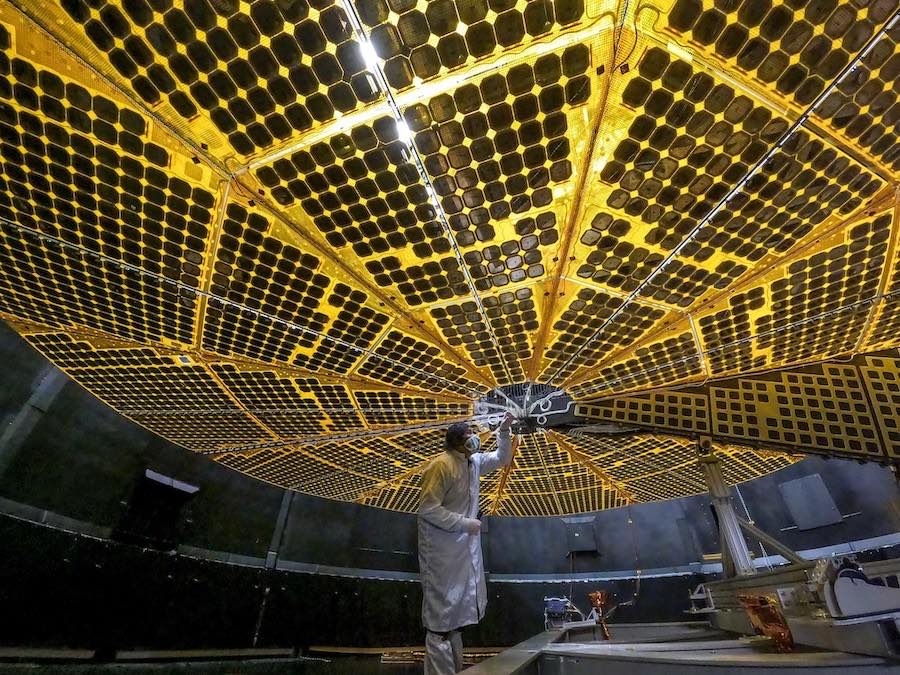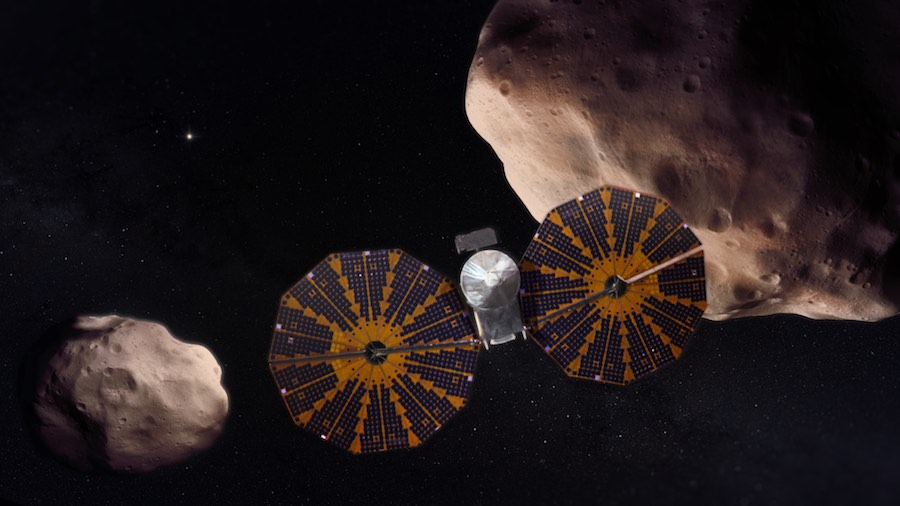
About an hour after launch Saturday, NASA’s Lucy spacecraft will start the delicate process of opening its circular, fan-shaped solar arrays — the largest ever on a deep space probe — to power the asteroid explorer’s 12-year journey into the outer solar system.
When it reaches the apex of its interplanetary orbital arc, the Lucy mission will become the most distant spacecraft to ever use solar power, breaking the record set by NASA’s Juno spacecraft orbiting Jupiter. Lucy will fly by eight asteroids during its mission, including seven objects in the Trojan swarms that lead and trail Jupiter in its orbit around the sun.
The mission is the first to explore the Trojan asteroids, which scientists say are leftover building blocks similar to objects that came together to form the solar systems giant outer planets.
To get there, Lucy will rely on a few engineering innovations.
“The most obvious feature that we have on Lucy is our gigantic, amazing solar array wings,” said Katie Oakman, structures mechanisms lead for the Lucy mission at Lockheed Martin, which assembled the spacecraft for NASA.
Covered in golden solar cells, the twin solar array wings were produced by Northrop Grumman. The circular arrays — sometimes dubbed “Mickey Mouse ears” — are upsized versions of the UltraFlex solar arrays used on Northrop Grumman’s Cygnus resupply ship for the International Space Station.
Each UltraFlex solar array on the Cygnus spacecraft measures about 12 feet, or 3.7 meters, across. The larger UltraFlex solar arrays on the Lucy mission each have a diameter of about 24 feet, or 7.3 meters.
The solar arrays launch in a stowed configuration folded up against the spacecraft. They take up less volume and are half the mass of a typical rigid solar panel for a spacecraft, according to Rich Lipe, the Lucy spacecraft program manager at Lockheed Martin.
The Lucy spacecraft is set for liftoff from Cape Canaveral Space Force Station at 5:34 a.m. EDT (0934 GMT) Saturday on top of a United Launch Alliance Atlas 5 rocket.
The two-stage, liquid-fueled launcher will accelerate the 3,300-pound (1,500-kilogram) Lucy spacecraft fast enough to escape the gravitational grasp of Earth and enter a heliocentric orbit around the sun.
Separation of the Lucy probe from the Atlas 5 rocket is scheduled 58 minutes after liftoff.
“About six minutes after that, we start deploying the solar arrays,” said Jessica Lounsbury, Lucy project systems engineer at NASA’s Goddard Space Flight Center. “It takes about 20 minutes for the simultaneous deployment of those arrays.”
“During deployment, there are literally thousands of tiny little mechanisms and flexures that are deploying those wings like a Chinese fan,” Oakman said.
Following an autonomous pre-programmed sequence, the Lucy spacecraft will begin priming its propulsion system and turn its solar arrays toward the sun to start charging batteries.
“Within about 30 minutes after separation, the solar array deployment should be complete, or almost complete,” said Cavan Cuddy, design lead for the Lucy spacecraft at Lockheed Martin.
Fully unfurled, the solar arrays cover an area of about 548 square feet, or 51 square meters.
“That enables Lucy to travel farther away from the sun than any other solar-powered spacecraft to date,” Oakman said. “When we’re near Earth, those wings have about 18,000 watts of power, so that would be equivalent to powering up my house and a couple of my neighbors.
“However, when we fly out to the Jupiter Trojan asteroids, we only have about 500 watts of power. So that would only light a few light bulbs in my living room, and it wouldn’t be enough to power up my microwave in the morning to warm up my coffee.”
That level power output is sufficient to feed Lucy’s three science instruments, which only need about 82 watts of power during each asteroid encounter. Lucy’s flight computer, communications system, and other components will also draw on power generated by the UltraFlex arrays.

Before missions like Juno and Lucy extended the reach of solar-powered science probes, spacecraft heading to the outer solar system required nuclear power sources. Plutonium power packs are more expensive and more difficult to handle during launch preparations.
Ground teams could start receiving intermittent signals from the Lucy spacecraft within 30 seconds of separation from the Atlas 5 rocket’s Centaur upper stage over Australia. But Lucy will wait until after the solar arrays unfurl to turn its antenna into a more favorable orientation for communications.
“We do begin transmitting right after separation,” said Cuddy. “Communication is not guaranteed, though, until it’s really about half an hour to an hour after we separate.”
Engineers at a Lockheed Martin control center near Denver will be on standby to receive the first signals from Lucy through NASA’s Deep Space Network, a range of ground antennas scattered around the globe.
Two days after launch, Lucy will deploy its instrument pointing platform, a two-axis gimbal system that will point the mission’s science instruments toward its asteroid targets during each flyby. The pointing platform is stowed with launch locks for the climb into space, and three separation nuts will fire to release the structure.
Lucy will circle back to Earth three times for slingshot maneuvers, using the planet’s gravity to propel itself deeper into the solar system. A series of deep space maneuvers using a Leros 1c main engine produced by Nammo in the United Kingdom will help steer Lucy along its unique trajectory.
The spacecraft will reach a distance of more than 500 million miles (800 million kilometers) from the sun at the farthest portion of its orbit. That’s slightly beyond the distance of Jupiter.
Email the author.
Follow Stephen Clark on Twitter: @StephenClark1.
